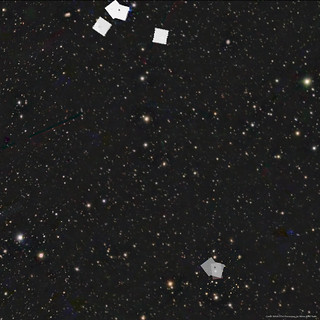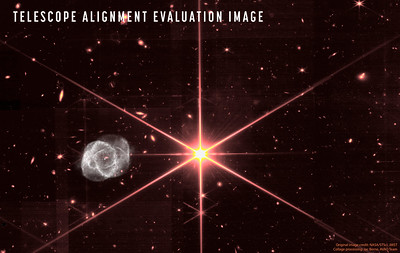Page 2 of 2
Re: APOD: 2MASS J17554042+6551277 (2022 Mar 19)
Posted: Sun Mar 20, 2022 4:05 pm
by johnnydeep
So, what explains the 8 diffraction spikes we see in this image? There are the six large equal spaced ones, which I assume are due to the hexagonal mirror segments, but there are also two small horizontal ones. Or are those not diffraction spikes at all and just "processing artifacts" as I thought might be being hinted at in some of the posts above? Also, where are the diffraction spikes caused by the three secondary mirror support struts?
Also, I notice that the diffraction spikes exhibit some striated complexity - what's causing that?
Re: APOD: 2MASS J17554042+6551277 (2022 Mar 19)
Posted: Sun Mar 20, 2022 4:40 pm
by Chris Peterson
johnnydeep wrote: ↑Sun Mar 20, 2022 4:05 pm
So, what explains the 8 diffraction spikes we see in this image? There are the six large equal spaced ones, which I assume are due to the hexagonal mirror segments, but there are also two small horizontal ones. Or are those not diffraction spikes at all and just "processing artifacts" as I thought might be being hinted at in some of the posts above? Also, where are the diffraction spikes caused by the three secondary mirror support struts?
Also, I notice that the diffraction spikes exhibit some striated complexity - what's causing that?
The secondary mirror is supported by two struts that are aligned with the hexagonal mirror vertices, and therefore their diffraction spikes overlap those from the mirrors themselves. The upper support strut, however, is aligned with the mirror edges and its diffraction pattern is seen in the much less prominent horizontal spikes.
Not sure about the striation. Might be related to the massive overexposure of this image and the effects of the internal mirror edges. Might try playing around with the math a little later.
UPDATE: Here's the aperture pattern (mirror segments and support struts), and the Fourier transform of that pattern, which is basically what the diffraction pattern is. (Zoom in for a better view.)
_
Re: APOD: 2MASS J17554042+6551277 (2022 Mar 19)
Posted: Fri Mar 25, 2022 3:36 pm
by johnnydeep
Chris Peterson wrote: ↑Sun Mar 20, 2022 4:40 pm
johnnydeep wrote: ↑Sun Mar 20, 2022 4:05 pm
So, what explains the 8 diffraction spikes we see in this image? There are the six large equal spaced ones, which I assume are due to the hexagonal mirror segments, but there are also two small horizontal ones. Or are those not diffraction spikes at all and just "processing artifacts" as I thought might be being hinted at in some of the posts above? Also, where are the diffraction spikes caused by the three secondary mirror support struts?
Also, I notice that the diffraction spikes exhibit some striated complexity - what's causing that?
The secondary mirror is supported by two struts that are aligned with the hexagonal mirror vertices, and therefore their diffraction spikes overlap those from the mirrors themselves. The upper support strut, however, is aligned with the mirror edges and its diffraction pattern is seen in the much less prominent horizontal spikes.
Not sure about the striation. Might be related to the massive overexposure of this image and the effects of the internal mirror edges. Might try playing around with the math a little later.
UPDATE: Here's the aperture pattern (mirror segments and support struts), and the Fourier transform of that pattern, which is basically what the diffraction pattern is. (Zoom in for a better view.)
_
JWST_optics_fourier.jpg
Wow, that is very cool. So you "merely" applied some sort of Fourier transform image processing algorithm to the mirror and strut and that magically produced the diffraction pattern we see?!
Re: APOD: 2MASS J17554042+6551277 (2022 Mar 19)
Posted: Mon Apr 25, 2022 5:33 pm
by Knistian
Regarding the resolution of the engineering-picture from JWST, where several think it's low: It has to do with wave-length. It's unfair to compare a picture taken in the UV-Visible range(where Hubbel opperates), and compare it directly with an image taken in the deeep part of the IR. The diameter of JWST is ca. 2.3 of Hubbel, so wavelengths 2.3 times as long as visible would be at the same resolution (with teoretical best acheivable resulution from both). The Webb has acheived to get a resolution at the wavelength used in the image, that is not limited by missalignement by the optics, but by fundamental limitations given by the diameter of the primaty mirror.
Re: APOD: 2MASS J17554042+6551277 (2022 Mar 19)
Posted: Mon Apr 25, 2022 5:53 pm
by AVAO
Knistian wrote: ↑Mon Apr 25, 2022 5:33 pm
AVAO wrote: ↑Sat Mar 19, 2022 4:34 pm
I'm a bit surprised that the quality isn't better than Hubble when comparing the resolution of details to the nearest Hubble object. The third image in the series shows the nearby Cat's Eye Nebula overlaid at the same size. But of course, the process of optimizing the instruments is not yet complete.
...
Regarding the resolution of the engineering-picture from JWST, where several think it's low: It has to do with wave-length. It's unfair to compare a picture taken in the UV-Visible range(where Hubbel opperates), and compare it directly with an image taken in the deeep part of the IR. The diameter of JWST is ca. 2.3 of Hubbel, so wavelengths 2.3 times as long as visible would be at the same resolution (with teoretical best acheivable resulution from both). The Webb has acheived to get a resolution at the wavelength used in the image, that is not limited by missalignement by the optics, but by fundamental limitations given by the diameter of the primaty mirror.
Thank's - That's right!
This is a very important consideration, which should definitely be taken into account in such a comparison.
Re: APOD: 2MASS J17554042+6551277 (2022 Mar 19)
Posted: Tue May 31, 2022 6:40 pm
by AVAO
Knistian wrote: ↑Mon Apr 25, 2022 5:33 pm
Regarding the resolution of the engineering-picture from JWST, where several think it's low: It has to do with wave-length. It's unfair to compare a picture taken in the UV-Visible range(where Hubbel opperates), and compare it directly with an image taken in the deeep part of the IR. The diameter of JWST is ca. 2.3 of Hubbel, so wavelengths 2.3 times as long as visible would be at the same resolution (with teoretical best acheivable resulution from both). The Webb has acheived to get a resolution at the wavelength used in the image, that is not limited by missalignement by the optics, but by fundamental limitations given by the diameter of the primaty mirror.
Here is a 1:1 comparison between the latest image from WEBB (2MASS J05230878-6925361) in the LMC and the identically sized section of 30 Doradus / RMC 136 also in the LMC. The center HST image in the bottom row is Near-IR/WFC3, while the Spitzer image is Mid-IR.
 https://live.staticflickr.com/65535/521 ... 1704_k.jpg
https://live.staticflickr.com/65535/521 ... 1704_k.jpg
original: https://live.staticflickr.com/65535/521 ... 03_o_d.jpg
https://live.staticflickr.com/65535/521 ... c28e_k.jpg
https://live.staticflickr.com/65535/521 ... d7b3_k.jpg
https://live.staticflickr.com/65535/521 ... b9db_k.jpg
Image Comparison: Jac Berne (flickr)
Original image sources:
HST Credit: NASA, ESA, and Z. Levay (STScI) https://esahubble.org/images/opo0932e
JWST Credit: NASA/ESA/CSA/STScI https://blogs.nasa.gov/webb/2022/05/09/ ... r-science/
SST Credit: NASA/JPL-Caltech/M. Meixner (STScI) & the SAGE Legacy Team http://legacy.spitzer.caltech.edu/image ... e-Infrared



